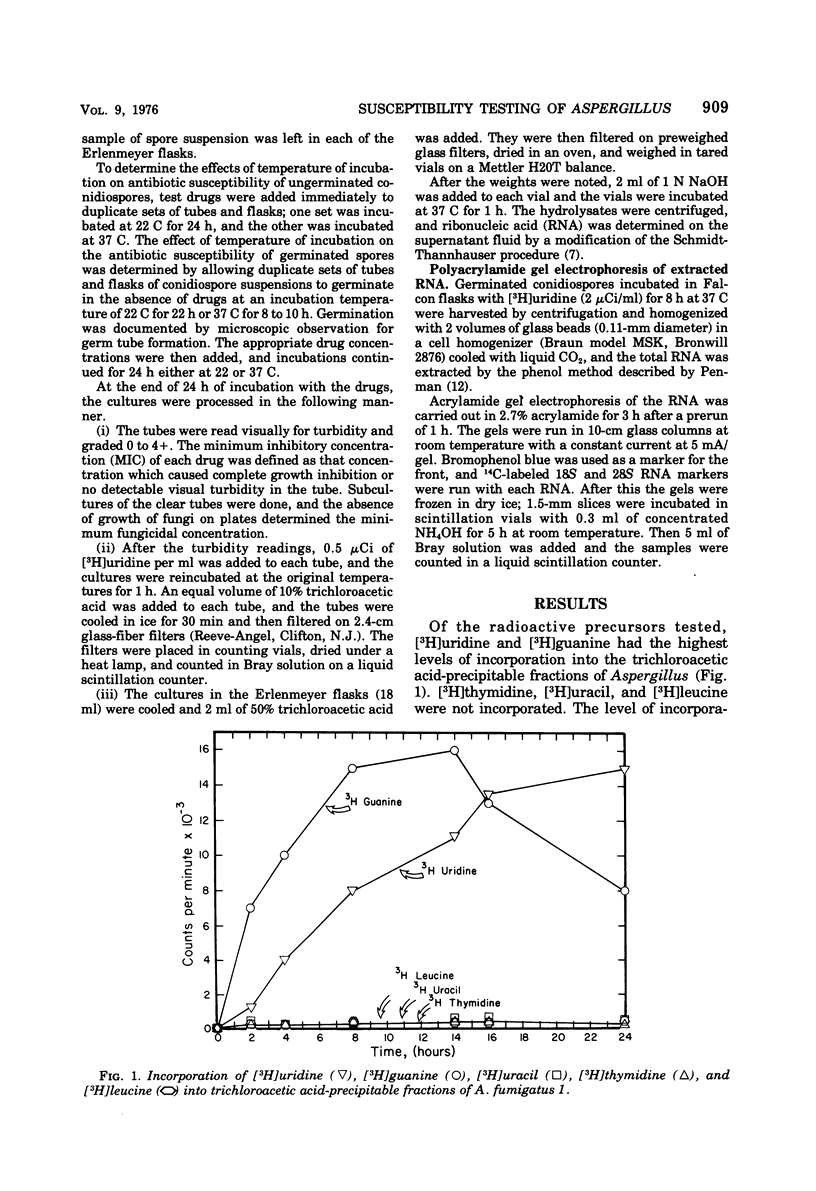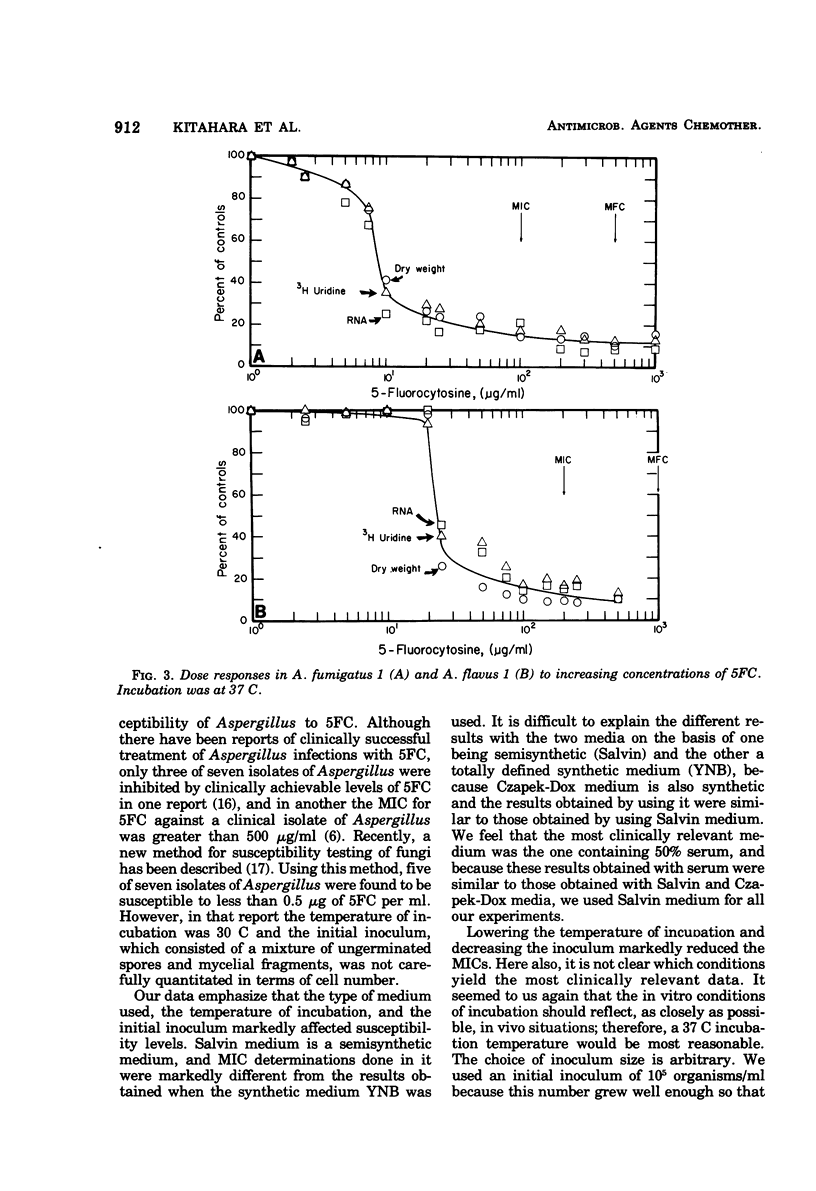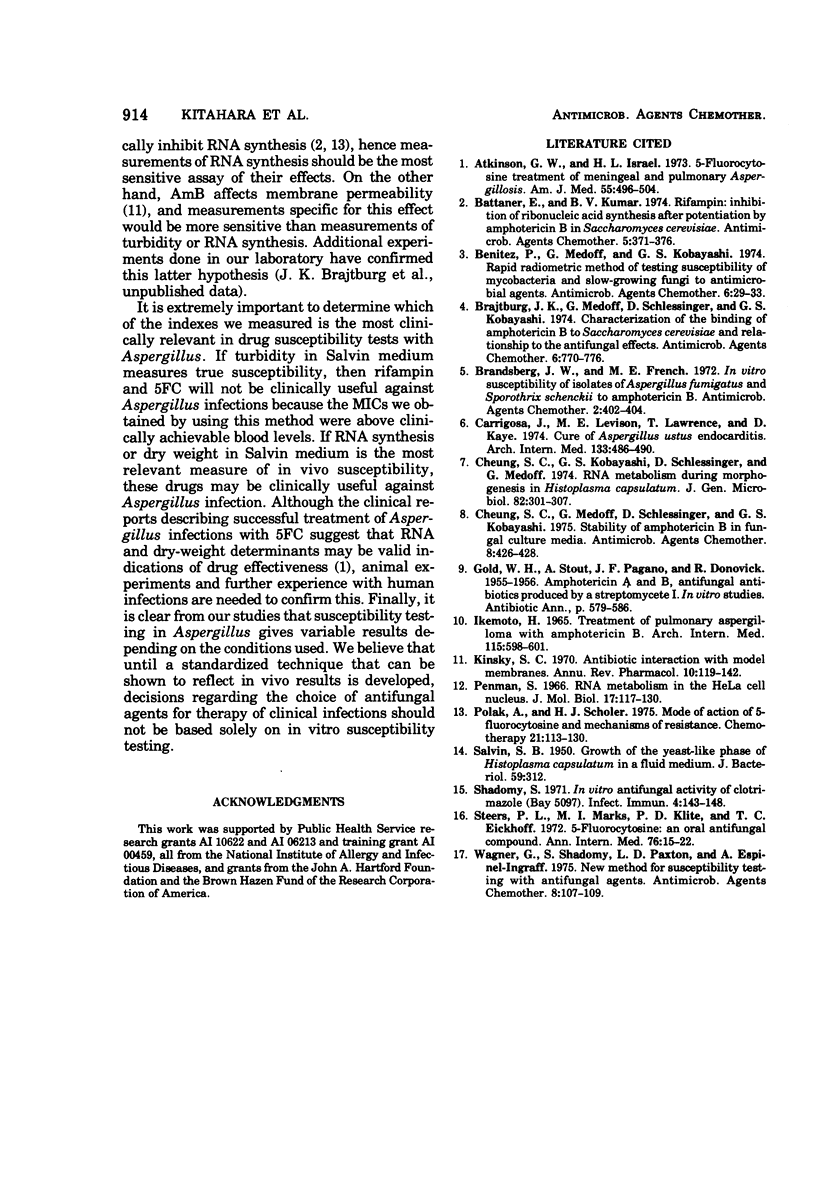Abstract
Several different methods of performing susceptibility tests on six clinical isolates of Aspergillus are described. Some of the conditions that affected the level of susceptibility to drugs were: the type of media used, temperature and time of incubation, and the initial inoculum size. For amphotericin B susceptibility testing, the effectiveness of the polyene antibiotic as measured by visual growth was equivalent to the effectiveness as measured by inhibition of ribonucleic acid synthesis and dry-weight increase. For 5-fluorocytosine and rifampin, the visual-turbidity method gave minimum inhibitory concentrations that were much higher than those determined by effects on ribonucleic acid synthesis and dry weight. The reason for these discrepancies in susceptibility testing with 5-fluorocytosine and rifampin are unknown. We conclude that the most relevant test of this fungus to antifungal agents will have to be determined by the correlation of in vitro data with animal experiments and clinical results.
Full text
PDF






Selected References
These references are in PubMed. This may not be the complete list of references from this article.
- Battaner E., Kumar B. V. Rifampin: inhibition of ribonucleic acid synthesis after potentiation by amphotericin B in Saccharomyces cerevisiae. Antimicrob Agents Chemother. 1974 Apr;5(4):371–376. doi: 10.1128/aac.5.4.371. [DOI] [PMC free article] [PubMed] [Google Scholar]
- Benitez P., Medoff G., Kobayashi G. S. Rapid radiometric method of testing susceptibility of mycobacteria and slow-growing fungi to antimicrobial agents. Antimicrob Agents Chemother. 1974 Jul;6(1):29–33. doi: 10.1128/aac.6.1.29. [DOI] [PMC free article] [PubMed] [Google Scholar]
- Brandsberg J. W., French M. E. In vitro susceptibility of isolates of Aspergillus fumigatus and Sporothrix schenckii to amphotericin B. Antimicrob Agents Chemother. 1972 Nov;2(5):402–404. doi: 10.1128/aac.2.5.402. [DOI] [PMC free article] [PubMed] [Google Scholar]
- Carrizosa J., Levison M. E., Lawrence T., Kaye D. Cure of Aspergillus ustus endocarditis on a prosthetic valve. Arch Intern Med. 1974 Mar;133(3):486–490. [PubMed] [Google Scholar]
- Cheung S. C., Medoff G., Schlessinger D., Kobayashi G. S. Stability of amphotericin B in fungal culture media. Antimicrob Agents Chemother. 1975 Oct;8(4):426–428. doi: 10.1128/aac.8.4.426. [DOI] [PMC free article] [PubMed] [Google Scholar]
- Cheung S. S., Kobayashi G. S., Schlessinger D., Medoff G. RNA metabolism during morphogenesis in Histoplasma capsulatum. J Gen Microbiol. 1974 Jun;82(2):301–307. doi: 10.1099/00221287-82-2-301. [DOI] [PubMed] [Google Scholar]
- DONOVICK R., GOLD W., PAGANO J. F., STOUT H. A. Amphotericins A and B, antifungal antibiotics produced by a streptomycete. I. In vitro studies. Antibiot Annu. 1955;3:579–586. [PubMed] [Google Scholar]
- IKEMOTO H. TREATMENT OF PULMONARY ASPERGILLOMA WITH AMPHOTERICIN B. Arch Intern Med. 1965 May;115:598–601. doi: 10.1001/archinte.1960.03860170080017. [DOI] [PubMed] [Google Scholar]
- Kinsky S. C. Antibiotic interaction with model membranes. Annu Rev Pharmacol. 1970;10:119–142. doi: 10.1146/annurev.pa.10.040170.001003. [DOI] [PubMed] [Google Scholar]
- Kotler-Brajtburg J., Medoff G., Schlessinger D., Kobayashi G. S. Characterization of the binding of amphotericin B to Saccharomyces cerevisiae and relationship to the antifungal effects. Antimicrob Agents Chemother. 1974 Dec;6(6):770–776. doi: 10.1128/aac.6.6.770. [DOI] [PMC free article] [PubMed] [Google Scholar]
- Penman S. RNA metabolism in the HeLa cell nucleus. J Mol Biol. 1966 May;17(1):117–130. doi: 10.1016/s0022-2836(66)80098-0. [DOI] [PubMed] [Google Scholar]
- Polak A., Scholer H. J. Mode of action of 5-fluorocytosine and mechanisms of resistance. Chemotherapy. 1975;21(3-4):113–130. doi: 10.1159/000221854. [DOI] [PubMed] [Google Scholar]
- SALVIN S. B. Growth of the yeastlike phase of Histoplasma capsulatum in a fluid medium. J Bacteriol. 1950 Feb;59(2):312–313. doi: 10.1128/jb.59.2.312-313.1950. [DOI] [PMC free article] [PubMed] [Google Scholar]
- Shadomy S. In vitro antifungal activity of clotrimazole (Bay b 5097). Infect Immun. 1971 Aug;4(2):143–148. doi: 10.1128/iai.4.2.143-148.1971. [DOI] [PMC free article] [PubMed] [Google Scholar]
- Steer P. L., Marks M. I., Klite P. D., Eickhoff T. C. 5-fluorocytosine: an oral antifungal compound. A report on clinical and laboratory experience. Ann Intern Med. 1972 Jan;76(1):15–22. doi: 10.7326/0003-4819-76-1-15. [DOI] [PubMed] [Google Scholar]
- Wagner G., Shadomy S., Paxton L. D., Espinel-Ingroff A. New method for susceptibility testing with antifungal agents. Antimicrob Agents Chemother. 1975 Jul;8(1):107–109. doi: 10.1128/aac.8.1.107. [DOI] [PMC free article] [PubMed] [Google Scholar]


